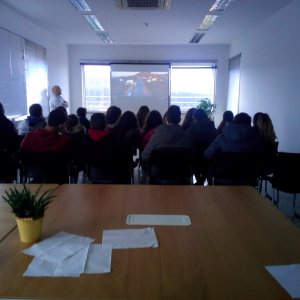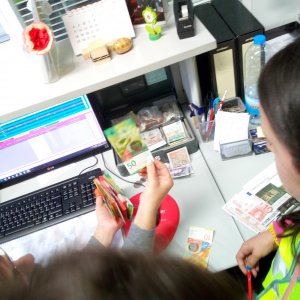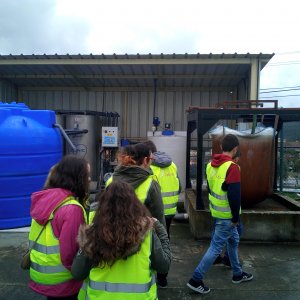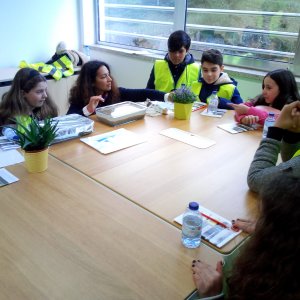

The journey of a Patinter truck driver
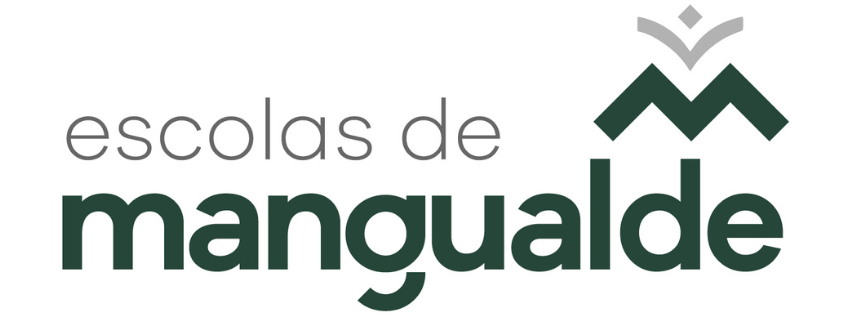
Activity description
Is it possible to learn Natural Sciences, Physical Chemistry and Mathematics through a Patinter truck driver's journey? This activity clearly answers the question, triggering a set of problems, tasks and questions in a real context, at the company, challenging students to actively engage in all requests. Students work on situations of direct proportionality with real data from the company, observe different types of terrain on the route that a truck driver took from Mangualde to England and visit the WWTP to discuss the processes carried out there.
-
6 tablets with the Student Guide created in Google Forms
-
Reflective vests
-
Participation certificates created by Patinter
-
Tree (Black Oak) to plant
Meet with the company to plan the activity, in order to discuss curricular content to be explored in the context, logistical issues , materials to be designed, as well as aspects of dynamism, particularly with regard to safety.
Ask the company to provide real data about its activity, especially those related to its fleet (speeds, distances, consumption, charges), to develop real problems to be explored in the context
If possible, send information about Patinter's environmental certification, for example about measures taken to reduce CO2 emissions/capture.
Request the sending of photos and videos taken by truck drivers, on their routes, when passing through mountains (folds and faults), for example in the Pyrenees, Alps and English Channel areas
Student profiles
Essential learnings
Please download the following files:
Activity guides
Introduction to the activity
The students are welcomed by the Patinter team at their facilities and move to a meeting room. A brief introductory video about the company (business activity, operations, and logistics) and its history is presented. The environmental certification process is mentioned, relating it to CO₂ emissions.
Next, the class is divided into two large groups, and tablets with the activity guides (see Student Guide) are distributed in digital format.
The two groups visit different points of the company, listening to presentations by company employees on topics related to each point and solving problems from the Student Guide.
Development of the activity
The two groups split up and visit the different designated points, always accompanied by a company employee and teachers.
Point 1 – A Truck Driver’s Journey
At this point, a Patinter staff member presents "A Truck Driver’s Journey" with some data related to a route taken by one of the company's drivers to England, highlighting data from the fleet management platform, the technology they have to monitor the truck fleet, the software used to record the real data from Patinter's fleet management platform and each specific truck, fuel consumption, truck routes, and photographs of landscapes (see images in Appendix 1), among other relevant aspects.
The importance of some data obtained from the software for the company's success is discussed with the students.

Parallel to the presentation, the students answer questions in the student guide.
The Mathematics teacher presents a problem related to direct proportionality, based on the data provided (e.g., consumption, speeds, distances), and asks the students to solve it in the guide.
Finally, the Patinter employee responsible for Point 1 should discuss Brexit from the perspective of its economic impact on the company. At the same time, they mention the need to consider the "exchange rate" between the Pound and the Euro in some company activities. This will help contextualize the issue to be explored by the students in Point 2.
Point 2 – Exchange Rates
The third stage of the activity is related to exchange rates. Using this stage, mathematical problems associated with it were created (e.g., direct proportionality function).
The students move to the location where the "cai a" (person responsible for exchanging money for drivers) is. It is also mentioned the importance of parking lots for heavy vehicles in England, with a brief reference to the phenomenon of illegal immigration.
Finally, a conversation in French is simulated with one of the company employees.

Point 3 – Visit to the WWTP (Wastewater Treatment Plant)
The student groups visit the WWTP. The students are explained the treatments carried out, describing the substances used in the wastewater treatment process for reuse, the number of vehicles, and the treatment process.
The Chemistry teacher presents a challenge related to solution concentration, linking water reuse with the sustainability of the planet.
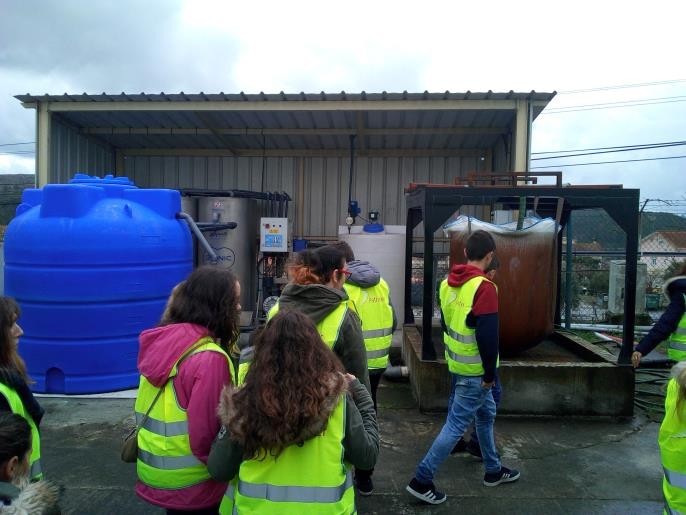
Point 4 – Practical Experimental Activity
After the visit to the WWTP, the students return to the meeting room where the visit began and observe an experimental activity related to the water treatment process, specifically the separation of solid waste.

Conclusion of the activity
After calculating an estimate of the CO₂ emission from a truck, based on the data provided by the company, and symbolically, a tree (English oak) is planted to sequester the CO₂ in the atmosphere emitted by the truck.
Finally, in the classroom, students are asked to solve Part II of the Student Guide. The teacher may consult the spreadsheet to further explore the problem with additional questions.
Extension Activity
Writing a letter to present to the Municipal Chamber of Mangualde, simulating a request from Patinter for the allocation of land to plant a number of trees to offset CO₂ emissions from the fleet of trucks over a year.
Annex 1
Essential learnings
Evidence / Student action
- Explicar a deformação das rochas (dobras e falhas), tendo em conta o comportamento dos materiais (dúctil e frágil) e o tipo de forças a que são sujeitos, relacionando-as com a formação de cadeias montanhosas.
- Identificar técnicas para separar componentes de misturas homogéneas e heterogéneas e efetuar a separação usando técnicas laboratoriais básicas, selecionando o material necessário e comunicando os resultados.
- Reconhecer uma função em diversas representações, e interpretá-la como relação entre variáveis e como correspondência unívoca entre dois conjuntos, e usar funções para representar e analisar situações, em contextos matemáticos e não matemáticos; Desenvolver a capacidade de abstração e de generalização, e de compreender e construir argumentos matemáticos e raciocínios lógicos.
- Resposta ao formulário.
- Resposta ao questionamento realizado na ETAR; Atividade prática apresentada por um elemento da empresa.
- Problemas relacionados com a área da matemática do formulário; Discussão dos dados sobre consumos, velocidades, ente outros apresentados por um elemento da empresa.
- Reconhecer uma função em diversas representações, e interpretá-la como relação entre variáveis e como correspondência unívoca entre dois conjuntos, e usar funções para representar e analisar situações, em contextos matemáticos e não matemáticos; Desenvolver a capacidade de abstração e de generalização, e de compreender e construir argumentos matemáticos e raciocínios lógicos.
- Problemas relacionados com a área da matemática do formulário; Discussão dos dados sobre consumos, velocidades, ente outros apresentados por um elemento da empresa.
Part I – Materials to be used during the visit to Patinter
Guide created from Google Forms used by students during the visit to Patinter: https://forms.gle/y2EEKf3xfmpNXXkg8
Examples of questions in the Guide created from Google Forms:
-
Task 3 – As you observed, Patinter has a wastewater treatment plant (WWTP) on its premises.
a) reception tank for solid retention of raw effluent
b) physical separation of the effluent
c) physical-chemical treatment system by evaporation
d) physical-chemical treatment system by flocculation -
Task 6 – Patinter is concerned with environmental issues. To reduce CO₂ emissions, it adds a substance to the fuel called Adblue. Observe the following table with data related to the trips made by the tractor with the license plate number 1.

Consider the data related to the first trips in January.
In the first trip, what was the cost of Adblue per liter of fuel (determine an approximate value to the hundredths)?
Is the relationship between the amount spent on Adblue and the fuel consumed a direct proportionality?
-
No, because there is no constant of direct proportionality between the two quantities.
-
Yes, because for each liter of fuel, 1 cent of Adblue is required.
Part II - Issue to explore after the visit to Patinter
Since trees are essential living beings for carbon dioxide capture and oxygen production through photosynthesis, conduct an investigation to answer the following problem questions:
Considering the data presented in the table below, which tree species has the greatest capacity for carbon dioxide capture?
|
Species |
No. of trees per hectare |
CO₂ sequestration per month |
CO₂ sequestration per tree per month |
|
English Oak |
81 |
0,441666667 |
0,005452675 |
|
Scots Pine |
500 |
2,166666667 |
0,004333333 |
|
Maritime Pine |
123 |
0,285833333 |
0,002323848 |
|
Cork Oak |
81 |
0,425 |
0,005246914 |
2. How many trees identified in the previous question need to be planted (approximately) to sequester the carbon dioxide produced by a truck that made the trip studied during the visit to Patinter? Consider that the truck traveled approximately 2580 km from Mangualde to the delivery location in England. Assume that the trees sequester carbon for 30 years.
2.1. What is the area of land in hectares needed to plant the number of trees calculated in the previous question?
2.2. Convert the area calculated previously to square meters.
2.3. If each tree of the species identified previously costs 1.75 euros, what is the amount that Patinter needs to spend to acquire the required number of trees to sequester the CO₂ emitted in 52 similar trips?



